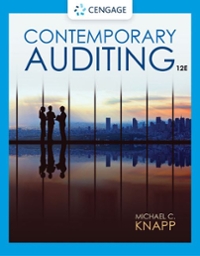On April 11, 2017, KPMG LLP announced that five partners and one employee of the firm had
Question:
On April 11, 2017, KPMG LLP announced that five partners and one employee of the firm had been dismissed for failing to disclose confidential information obtained illicitly from the Public Company Accounting Oversight Board (PCAOB). According to the KPMG press release, the six individuals "either had improper advance warnings of engagements to be inspected by the PCAOB or were aware that others had received such advance warnings and had failed to properly report the situation in a timely manner." Lynne Doughtie, KPMG's CEO at the time, noted that her firm "has zero tolerance for such unethical behavior. Quality and integrity are the cornerstones of all we do and that includes operating with the utmost respect and regard for the regulatory process . . . We are taking additional steps to ensure that such a situation should not happen again."
The five partners KPMG dismissed included Scott Marcello, the firm's Vice-Chair in charge of its U.S. audit practice, and David Middendorf, Marcello's top subordinate who held the title of National Managing Partner of Audit Quality & Professional Practice. Middendorf was also serving at the time on the PCAOB Standing Advisory Group that makes recommendations to the agency concerning new auditing standards.
Since 2004, the PCAOB has performed regular inspections of the hundreds of independent accounting firms registered to perform public company audits-Big Four firms are required to undergo annual inspections. The investment community, academic researchers, and the Big Four firms themselves closely monitor those inspection results since they provide an independent and powerful measure of the quality of the firms' audit services.
Shortly after KPMG announced the firing of the six employees, Compliance Week, a periodical focusing on regulatory issues in the business domain, noted caustically that KPMG had needed any "edge" it could obtain to improve its PCAOB inspection results. For the prior two years, the New York Times had characterized those results as "abysmal." In 2016, the PCAOB had reported a 38 percent "deficiency rate" for the nationwide sample of 2015 KPMG audits inspected. That deficiency rate ranked as the highest among the Big Four firms. In 2015, the PCAOB reported a 54 percent deficiency rate for the 2014 KPMG audits inspected, which was nearly double the average deficiency rate that year for the three other Big Four firms.
The heavy attention focused on the annual deficiency rates reported by the PCAOB has become a growing source of pressure and discomfort for not only the leadership of the Big Four firms but for their individual audit partners as well. In fact, in May 2016, David Middendorf told a reporter that PCAOB inspections were "an area of stress" and were causing some audit partners to "leave our profession." KPMG's disappointing PCAOB inspection results had prompted the firm to place the highly-respected Scott Marcello in charge of its U.S. audit practice in July 2015.
With the exception of a two-year term with the Financial Accounting Standards Board, Marcello had spent his entire professional career with KPMG and had served for several years on the firm's managing board. As the Wall Street Journal reported in April 2017, Marcello "was supposed to be the man to redeem KPMG LLP's audit business," a mission that included reducing the firm's PCAOB deficiency rates. Unfortunately, instead of boosting KPMG's image, Marcello "became the center of a scandal that [further] tarnished the firm's reputation."
Questions
1. Identify the PCAOB’s reported deficiency rate for each Big Four firm for each of the past five years. Comment on any discernible trends in the firms’ deficiency rates.
2. Each year, the PCAOB posts to its website a report that summarizes the findings of the agency’s most recent annual audit inspections. That report identifies the most common audit deficiencies found by PCAOB inspection teams. Review the most recent summary inspection report prepared by the PCAOB. What were the most common audit deficiencies identified by PCAOB inspection teams during the year in question?
3. What measures could Big Four firms take to mitigate the stress imposed on individual audit partners by the PCAOB inspection process? How effective do you believe the measures you identified would be in mitigating that stress?
Step by Step Answer:






